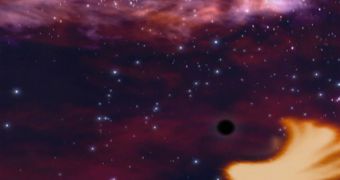Light echoes are generated when interstellar or intergalactic gas is ionized by electromagnetic emissions originating several light years away, and responds accordingly by releasing the surplus energy by emitting light. By observing such light echoes, astronomers can witness events that occurred several hundred of thousand years into the past, like supernova explosions or even a black hole in a 'feeding' process.
You might have noticed in the news this week that by observing a light echo, researchers have even been able to accurately calculate when the supermassive black hole in the center of our galaxy was last active, approximately 300 years ago. By using a similar technique, Stefanie Komossa from the Max Planck Institute fro extraterrestrial Physics observed a massive X-ray emission created by a supermassive black hole, located in the galactic nuclei of a distant galaxy.
Komossa believes that the X-ray burst might have been determined by a stream of material from a star in the center of the galactic nucleus, which was swallowed by the black hole. Although the X-ray light echo did not reveal any stellar disruption process, it could be used as a mean to map the nucleus of the respective galaxy.
Matter accreted by a black hole is shaped into a matter disk before falling towards the singularity. Friction inside the gassy structure heats matter to extremely high temperatures, at which point it starts to emit large amounts of electromagnetic radiation, especially in the X-ray wavelengths, illuminating the surrounding area.
"To study the core of a normal galaxy is like looking at the New York skyline at night during a power failure: You can't learn much about the buildings, roads and parks. The situation changes, for example, during a fireworks display. It's exactly the same when a sudden burst of high-energy radiation illuminated a galaxy," says Komossa.
The thing is that these light echoes, and X-ray emissions in particular, last for a very short time. Aside from revealing the origin of the emissions by measuring the ionization strength, light echoes can also provide an inventory of the illuminated atoms.
Towards the end of 2007, the Sloan Digital Sky Survey revealed a strong iron line emission in a galaxy dubbed SDSSJ0952+2143, evidence of the presence of a molecular torus inside the galaxy. These molecular toruses present high importance to creating a unified galaxy model, which states that all galaxies are made out of the same basic components. The molecular torus is surrounding both the black hole and its accretion disk, thus blocking direct view from certain directions in space.
By observing a light echo originating from the central supermassive black hole however, Komossa was able for the first time to create a map of the torus, something which hasn't been done before. Alternatively, researchers observed variable infrared light emissions characteristic to the reaction of the material torus before being completely destroyed by the radiation emissions coming from the black hole.
Amongst the iron line emissions, Komossa was able to detect for the first hydrogen emissions, associated with the accretion disk of matter spinning around the black hole.
"Probably we are seeing the debris of the disrupted star here which is just being accreted by the black hole," says co-author of the study, Hongyan Zhou from the MPE.
The X-ray light echo is still visible and is being observed with X-ray telescopes, such as Chandra, however the emissions are already showing a decrease in brightness. "Reverberation-mapping of light echoes opens up new possibilities to study galaxies," says Komossa, this is why she and her team is trying to explore the conditions within the circumnuclear material in active and non-active galaxies.

 14 DAY TRIAL //
14 DAY TRIAL //